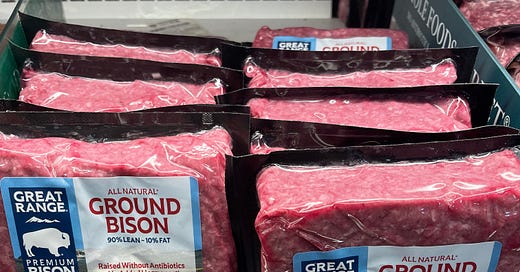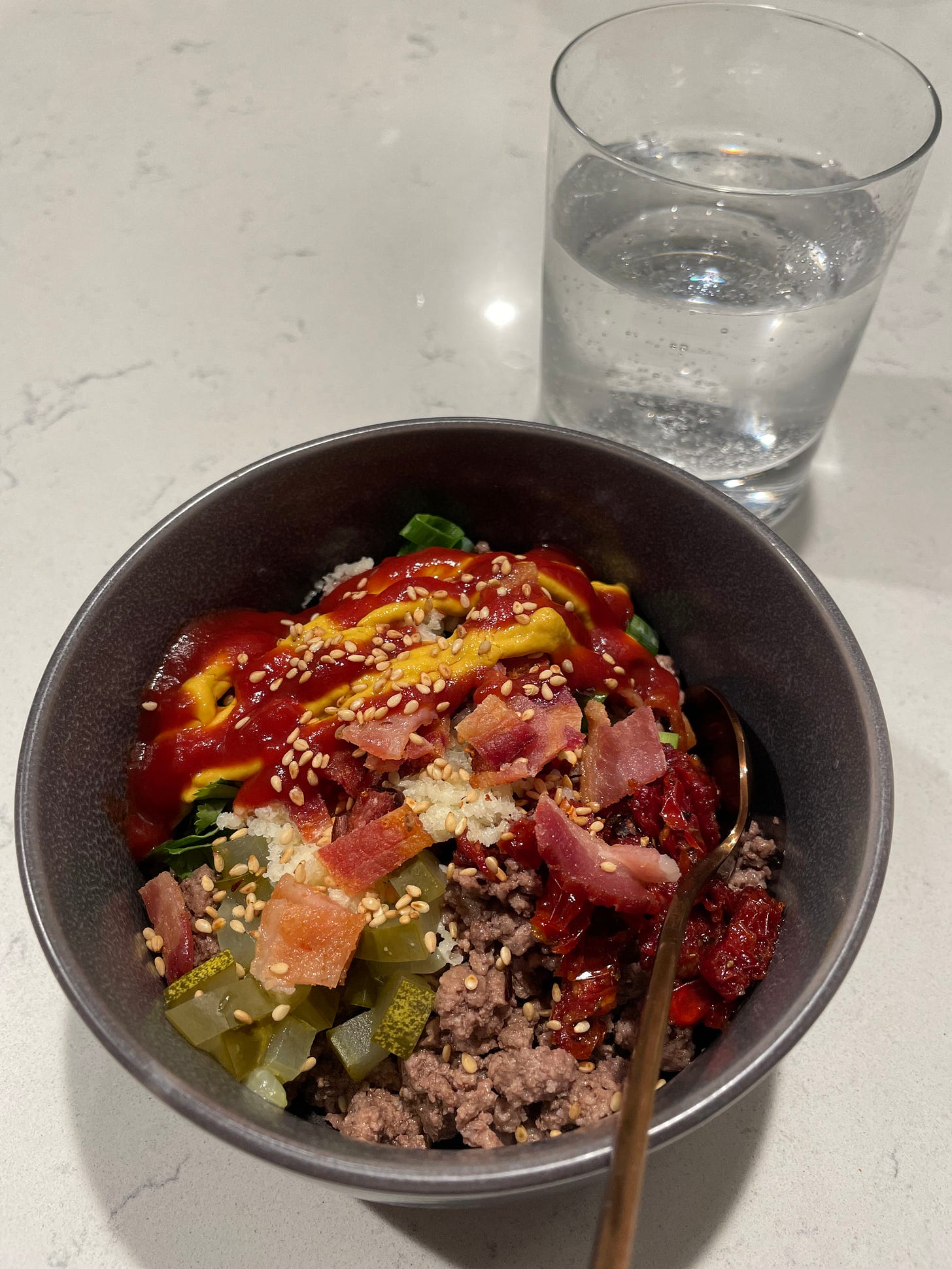This can barely be called a recipe, but here are some guidelines for one of our favorite fast low-carb, high protein meals: the bison burger bowl.
Serves: 2-3 (depending on how hungry you are)
Time: <15 min (achievable for those of us without culinary skills)
Ingredients:
This varies and depends on your burger topping preferences, but generally, here’s suggested what you need:
1lb (16oz) ground bison (all bison is grass fed, without added hormones or antibiotics, and generally sustainably produced through regenerative agriculture, so you won’t have to look for an organic label) (our favorite bison meat company is Great Range, and favorite ranchers are Northstar Bison, Rock River Ranches, and Virginia Bison Co).
Sea salt (our favorite is Z&Z’s sea salt harvested from the Dead Sea in the West Bank, high in mineral content)
Black pepper
Onion powder
Garlic powder
Diced kosher dill pickles
Leafy green or herb (chopped romaine, parsley, or cilantro – the “carnivore diet community,” does not approve of this ingredient, but it adds to the aesthetic and crunch)
Sun-dried tomatoes (we’ve recently been adding sun-dried tomatoes found in olive oil to our bowls, and that has been the *chef’s kiss*, again, not strict carnivore diet-friendly but key to any burger I like to eat)
1-2 Diced onions (we prefer green onions because they’re easier on the body and more colorful; a diced shallot is another option))
¼ - ½ avocado
3 slices of crispy bacon
Shredded block cheese (we prefer sharp cheddar)
Sesame seeds! (a must for a complete burger feel; we get ours at the Korean grocery store, H-Mart)
Ketchup (recommend Trader Joe’s Organic Ketchup – little added sugar, delicious, and NO high fructose corn syrup; only complaint is that it’s in a plastic bottle)
Mustard of choice
Mayonnaise (we don’t use it, but it’s a burger staple for some!)
Crushed red pepper flakes
Any other toppings you like on your home-grilled burgers
Directions:
Heat a skillet on your stove; add the ground bison; break up the meat a bit with your preferred tool used to cook ground meat (we use a four-prong ground meat chopper); season with salt, pepper, onion powder, and garlic powder, to taste; cook until medium-well browned. Drain excess liquid from skillet, and place cooked bison in a serving dish.
Heat a separate skillet and add the three strips of bacon. Cook on one side until very browned and crispy. Flip and repeat on the other side until well done. Sometimes I take the bacon off the skillet with tongs and place on a paper-towel lined plate to remove the extra grease. Regardless, allow bacon to slightly cool to a comfortable temperature to hold in your hands.
Before or after cooking the meat or in-between monitoring the seasoned ground bison and bacon, cut up any toppings that need to be chopped and place them all in separate little serving bowls. For example, chop the pickles, onions, greens, and cheese of choice.
When bacon has cooled to a reasonable temperature, break it apart into small bits and place it in another small bowl.
Set all your toppings and condiments out on your dinner table along with the dish of bison to create a self-service station.
Let everyone assemble their bowls and enjoy!
I like to assemble my bowl with the bison first, then go around in a circle with other toppings, reserving the bacon and cheese for the middle, then top the dish with drizzled ketchup and mustard, and last, sprinkle the bowl with sesame seeds.
Hope you enjoy your bowl! Please leave your own go-to, quick weeknight recipe names below, and read on if you’d like to see how this became one of our staples.
The story:
When Peter and I first met, he did the bulk of the cooking for us. The first time I cooked for him, I made us bowls, with lots of leafy greens and roasted vegetables, without any meat, thinking garbanzo beans would provide enough protein to satiate him. He ended up eating a Greek yogurt and four eggs after to make up for his “lost protein.”
After dating longer and observing more of my cooking, eating, and exercise habits, Peter noted that I didn’t eat enough protein. We stated what we each thought was a healthy amount of protein to eat in a given day, and our ideas were very different. While Peter ate his body weight in protein, 150g, I was eating less than half of my body weight, targeting 50g per day, often not even reaching that amount, and thinking that was sufficient. Come to find out, it is recommended that female athletes eat about 1.2-1.4g of protein per kilogram of body weight, approximately 65-92g for a 120lb woman – much more than I had even been “targeting.” As a female marathoner, my protein intake wasn’t cutting it.
Taking advice from another (significantly faster) marathoner, I wanted to try incorporating more protein into my diet as fuel for all the demands I put on my body. In a joint cookbook, Run Fast, Eat Slow, American Olympian and marathon silver medalist, Shalane Flanagan, writes with her former college teammate and current nutritionist, Elyse Kopecky, about how much she loves cooking bison burgers when doing intense training at high altitudes and how much she loves a high-quality burger to fuel her training and help her recover after races. On their blog titled the same as the cookbook, Run Fast, Eat Slow, Kopecky notes in this post:
“Burgers can be surprisingly nutrient-dense if you start with high quality grass-fed ground beef or bison. Red meat is a great source of protein, healthy fats, energizing B vitamins, and blood-building iron.”
-Elyse Kopecky, Co-Author of New York Times Best Seller Run Fast, Eat Slow
Unlike Flanagan and Kopecky, at the time when I first realized I was severely undershooting my protein intake, I didn’t enjoy cooking meat because I didn’t know how to cook it well, and it didn’t seem worth learning. Peter, on the other hand, ate plain ground beef for lunches daily to meet his protein requirements. As someone who enjoys the taste of food, Peter’s approach didn’t seem worth pursuing.
Fast forwarding to the beginning of the COVID-19 pandemic, we were spending a lot of our days co-teleworking in Peter’s studio apartment and eating our lunches together. Peter, still appalled at my lack of my protein, especially after myself just having trained for a marathon cancelled less than two weeks before St. Patrick’s Day 2020, asked if I would try eating some ground turkey for lunch. He promised the extra protein wouldn’t make me bulky and said I could always stop eating it if I wanted to, so I gave it a try.
Peter always ate his ground turkey or beef with sriracha alone, but that would not work for me. I needed other flavors to enjoy this otherwise bland dish. I started topping it with ketchup and mustard, reminding myself of the way I used to eat burgers at cookouts as a kid. I never liked burger buns, so I always put just a plain burger on my plate, cut it up with my fork in small pieces, and dipped it in the ketchup and mustard I mixed together on my plate as an orange sauce.
When I became a teenager, not much changed, but I started adding a tomato and lettuce slice to the top of my burger patty, cutting the three things up together, and dipping them in the ketchup and mustard as I had done most of my life. I progressively added more condiments, including pickles, cheese, and avocado, and one day called it a burger bowl. Peter said it looked delicious and was a great idea. He started adding more things to his ground beef/turkey lunches too.
After we got married in November 2021, we rarely ate dinner together, but several months later that changed. Somewhat randomly, I asked if we could eat dinner together every day if I planned it and cooked. I channeled my late grandma and began making a weekly menu that hung on our fridge and significantly expanded the number of days I cooked for us and the number of meals we ate together. Burger bowls became a staple on our weekly menus, as predictable as “chicken Mondays” and “taco Tuesdays.”
Having some ground bison in the freezer once from Rock River Ranches, we tried using it for our burger bowls and decided we liked the taste of it more than beef because of its freshness, overall leanness, and weird ease of cooking without being clumpy like ground beef. This prior post on bison also mentions some of the environmental and health benefits of eating it over beef. Now we have bison burger bowls almost once a week with similar but slightly different toppings. It’s the fastest dish we cook all week, and super tasty.
Email us photos of your meal bowls or other creations to share ideas and expand our collective creativity at peter@catalystfoodsco.com, we’d love to hear from you in the comments section below!
👉If you enjoyed this post, feel free to share it with friends!
Related Articles:








Great recipe Julie! Looks delicious
Love the variety and idea here! Peter is lucky to have someone who supports his cause, but also is creative enough to come up with such delicious and healthy meals!